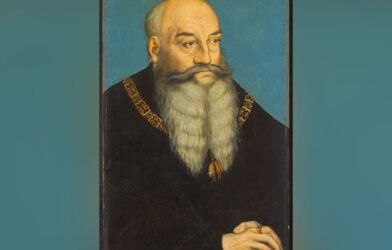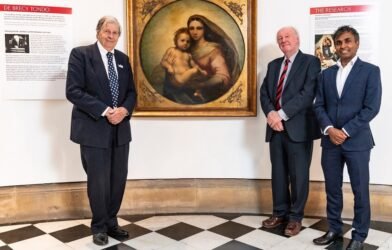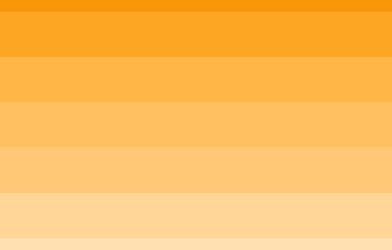Art Market
Maxwell Rabb
Portrait of Jonathan Carver Moore. Photo by Kari Orvik. Courtesy of Jonathan Carver Moore
Jonathan Carver Moore often walks his dog by his eponymous gallery on Market Street in San Francisco’s Tenderloin neighborhood, pausing to listen to how passersby react to the artwork in the giant glass windows. It might seem like a simple eavesdropping exercise, but for Moore, it’s fueled by a serious commitment to considering the opinions of his local community.
“I know what it feels like to be an outsider,” Moore told Artsy. As the first openly gay Black male gallerist in San Franscisco, Moore opened his gallery based on the belief that the art world should be accessible. Moore has lived in the Tenderloin neighborhood since he moved to the Bay Area nine years ago, and founded his gallery in 2023 with a program centered around BIPOC, LGBTQ+, and women artists. “How can we make sure that we’re really hearing from them and doing so in a space or a gallery that understands what they’re going through?” the gallerist said of his approach.
Aplerh-Doku Borlabi, installation view of “BOLD” at Jonathan Carver Moore, 2024. Photo by Jonah Reenders. Courtesy of Jonathan Carver Moore.
Barely a year after breaking ground, Jonathan Carver Moore has not only become a notable presence in the Bay Area art world, but has also made waves elsewhere. He’s already participated in five art fairs, including EXPO Chicago, Investec Cape Town Art Fair, and Untitled Miami, and has found time to launch a residency program before the gallery’s first anniversary, taking over an empty 2,600-square-foot space next door. The first artist to take part in the seven-week program Ghanaian painter Aplerh-Doku Borlabi, has just wrapped a solo show at the gallery, “BOLD,” which closed on June 15th.
This meteoric success is nearly unprecedented for a relative newcomer to the commercial art world. Raised in a military family, Moore pursued studies in sociology and women’s studies, followed by a master’s in public relations at George Washington University. An engagement with art was a fixture of Moore’s childhood, and he fondly recalls visiting museums such as the Louvre, the Hirshorn, the National Gallery of Art, and the Met with his mother as a child—an experience he credits with embedding the arts as a key part of his life from an early age.
Moore began his career in the nonprofit sector with roles at United Way Worldwide and Out & Equal before joining the Rosenberg Foundation, a nonprofit that works towards racial and economic justice in California. While at Rosenberg, he had the chance to dive into the Bay Area art scene, proposing that he curate a selection of local artists, such as Lucky Rapp and Lena Gustafson, at the foundation’s headquarters.
In 2020, Moore set up the online journal ARTUCATED to share art and stories from BIPOC, LGBTQ+, and women artists from around the world, and by 2021, he took a leap of faith to fully enter the art world and joined the Institute of Contemporary Art in San Francisco. Still, Moore found that the institutional world often lacked the agility needed to address social issues promptly. “Unfortunately, you’re not always able to move as fast as one would like to when it comes to responding to what’s happening to us or what’s happening around us,” he said. Fueled by this realization, he decided to open his own gallery, a space designed to rapidly adapt and engage with the evolving cultural landscape.
The gallery’s inaugural show featured Kacy Jung, a Taiwanese immigrant whose work discusses themes of identity and cultural assimilation—a poignant choice that underpinned Moore’s commitment to giving a platform to voices that resonate deeply with personal and collective narratives. After coming across her work at Root Division, a San Francisco–based nonprofit focused on arts education where Moore is a board member, he realized how closely her work aligned with his personal vision. This exhibition set the stage for the gallery, highlighting its focus on bringing marginalized voices to the forefront.
Moore emphasizes the need for a careful balance between commercial considerations and boundary-pushing. This thoughtful, realistic approach allows the gallerist time to take risks on new artists while prioritizing security for his gallery and the artists he exhibits.
Portrait of Jonathan Carver Moore outside his eponymous gallery. Courtesy of Jonathan Carver Moore.
“It’s maintaining this balance of what I want to keep showing and why I started, my true vision versus what is just sellable,” said Moore. “So if you’re going to do six shows a year, maybe four out of the six shows are shows that you can bank on.…But then I should have a wild card, right? That ‘wild card’ is often the one that might be the one that surprises everyone, and you have another breakout artist.”
With the gallery’s new residency program, Moore aims to forge connections between Bay Area artists and the global art community. For example, during Borlabi’s residency, the gallery organized events that allowed locals to engage directly with the artist. Visitors could converse with Borlabi, observe his creative process, and gain deeper insights into his artistic journey. Above all, it’s about grounding framing the art world with inclusivity rather than obscurity, Moore said.
“I feel like when you have that deep connection to the art, then you have a better understanding of its value, worth, and its beauty,” Moore said. “And we want to do the same with the other individuals who would be a part of the residency.”
Moore just opened his ninth show at the gallery, “Infinite,” featuring work from lens-focused artist Victoria Mara Heilweil. In the future, the gallerist plans to host Cameroonian artist Sesse Elangwe at the residency, as well as Indian artist Anoushka Mirchandani, whom the gallerist is hoping to show at next year’s hometown FOG Art + Design Fair.
One show Moore is particularly enthusiastic about is a photography exhibition from South African artist Pieter Hugo, planned to open near the end of August or the beginning of September. This show will focus on Hugo’s compelling body of images featuring the Tenderloin district during his time as a resident at the Headlands Center for the Arts in Marin County. These works immortalize “a neighborhood that people often avoid,” in Moore’s words, by representing people of color, queer people, and those facing poverty who are otherwise overlooked.
As the gallery continues to make headway, Moore remains steadfast on the mission that has guided it to this point thus fair—intersecting art with advocacy to foster an environment where every exhibition is a step toward inclusivity. “I’m merging two lives that I want to see come together: wanting to help people and then wanting people to see art and the gallery,” he said.
Maxwell Rabb
Maxwell Rabb is Artsy’s Staff Writer.









